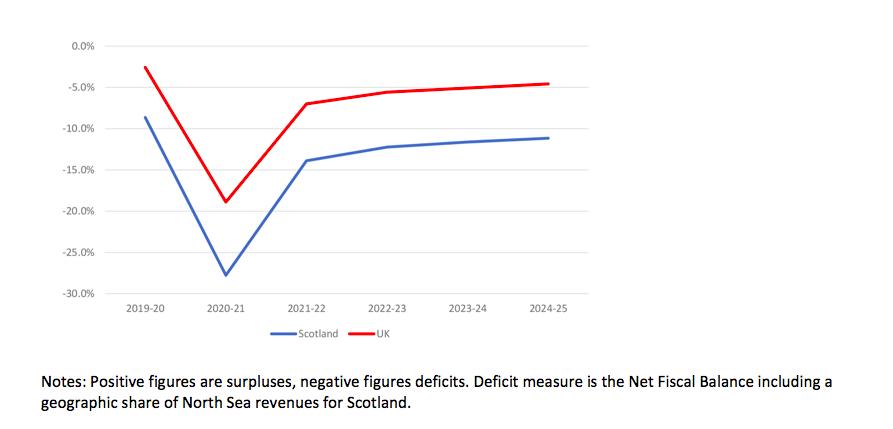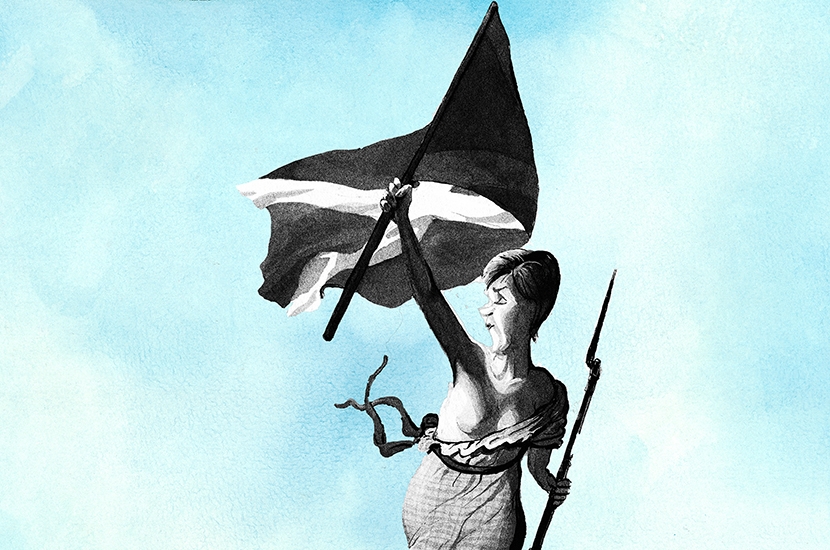As the world continues its fight against Covid-19, the Scottish National Party has been busy plotting Scotland’s exit from the UK. If the party gets its way and wins another referendum, Scots could soon find themselves living under a ‘sterlingisation’ currency system. The implications could be disastrous.
It would be wrong to dismiss talk of another referendum as hypothetical. Powers over the UK’s constitution may sit with Westminster, but recent polling demonstrates a sustained (small) majority for secession. The SNP continues to ride high in the polls, looks set to win convincingly in May’s Holyrood election and has announced it intends to hold another referendum without UK government approval, if necessary. Boris Johnson’s ‘once-in-a-generation’ stance might be tested to breaking point.
So if Scotland does vote out, how might it fare economically? And how will it tackle the thorny issue of its currency regime once formally outside the sterling zone?
A report published by the SNP’s Sustainable Growth Commission – a group set up by the party to provide a credible economic blueprint for separation – gives some answers. The plan, according to the 2018 document, is to use the British pound unofficially while running an independently managed Scottish financial system with a Scottish Central Bank (SCB) at its core. The SCB will provide liquidity support to Scottish retail banks. It will also act as a lender of last resort, provide a payments system for clearing transactions in Scotland and will be banker to the Scottish Government.
Using another country’s currency unofficially (often referred to as ‘dollarisation’, given the dominance of the US dollar) is not uncommon. A number of emerging market countries have experimented with this in recent decades in an effort to import credibility to their financial systems and control inflation. But applying such a model – in this case ‘sterlingisation’ – to the break-away part of an advanced economy would be a first.
A risky experiment?
‘I think it would be a hugely risky experiment for Scotland,’ says Dame DeAnne Julius, one of the founding members of the Bank of England’s Monetary Policy Committee. ‘The evidence one could look to for this kind of arrangement are places that are quite different and at a different development level – places like Argentina – and it’s impossible, I think, to find any place that is a success story undertaking this route of political independence using a currency issued by another country.’
‘I think Scotland would have to undergo a profound change and would probably have to make some difficult economic adjustments,’ says Harvard University economics professor Jeffrey Frankel, who served on the US President’s Council of Economic Advisers during the Clinton administration.
Scotland could also face a greater risk of a run on its banks under a sterlingised system
Sterlingisation has important implications for two different, but related, issues: the stability of the banking system, and the ability of the economy to absorb macroeconomic imbalances. So how would Scotland fare?
On the macroeconomic position, the new state would start with a large fiscal deficit and a large current account deficit (the current account is a key component of the balance of payments, which is a measure of all cross-border transactions over a particular time period).
According to Scottish Government data, Scotland’s implicit budget deficit for 2019/20 was 8.6 per cent of Scottish GDP. This meant the country spent £15 billion more than it raised in taxes, while Scotland’s trade figures suggest persistently large current account deficits. The current account deficit for 2017, the latest year for which firm data exists, was around 7.6 per cent of GDP, and was ten per cent of GDP in 2016.

The pandemic has made matters worse: the UK’s Institute for Fiscal Studies estimates Scotland’s 2020/21 budget deficit at 26-28 per cent of GDP, and projects double-digit Scottish deficits through to 2025.
With Scotland inside the United Kingdom, these imbalances are manageable. Fiscal transfers from the UK Government mean that Scotland can run persistent deficits without relying on borrowing from capital markets. And the Bank of England ensures that Scottish banks have the liquidity necessary to keep the economy moving. This system also ensures households and businesses can access credit and rely on deposit insurance on the same terms in Scotland as anywhere else in the UK.
But with independence, the fiscal deficit would have to be plugged by borrowing on capital markets. Scottish banks could no longer rely on the Bank of England for liquidity. This is a significant issue when Scotland’s current account balance means there would be a substantial outflow of sterling from the Scottish banking system.
‘Scotland has no credit history and would have an unstable macroeconomic situation, so debt issued by its central bank would be high risk for investors, who would demand a high interest rate to hold it,’ says Julius. ‘Those higher interest costs would be a huge additional burden to a Scottish government that ran a budget deficit needing to be financed by debt.’
‘Looking at the massive Scottish fiscal and current account deficits, my advice to the new prime minister, should the country split off, would be to address these structural challenges or develop good links with the IMF [International Monetary Fund], because she or he might well need their assistance in the future,’ says professor Cédric Tille, member of the Bank Council of the Swiss National Bank. ‘This is a big problem for Scotland. It’s really reliant on external funding.’
There are ways to address the imbalances. Recessions can turn trade deficits into surpluses, while large tax rises or cuts in government spending (or a combination of both) would cut the fiscal deficit. The SNP’s Sustainable Growth Commission advocates bringing Scotland’s budget deficit down gradually over ten years via spending restraints. But it seems clear that large-scale government spending cuts and/or tax rises would be required immediately.
‘Essentially, if you’re going to be effectively using someone else’s currency then you’ve got to be extremely fiscally prudent,’ says Charles Goodhart, Emeritus professor of banking and finance at the London School of Economics.
An unstable banking system
Would Scotland’s commercial banking system cope if the country became independent? There are fears it might not. These worries stem from the ability of the new SCB to be a credible lender of last resort. The Sustainable Growth Commission makes the case that financial support would only be provided to ring-fenced retail banks operating in Scotland. It says these institutions would be regulated to ‘ensure that adequate collateral is available to match retail deposits in such banks’.
It also assumes that the very large Scottish banks, Royal Bank of Scotland (RBS) and Lloyds Banking Group (which Bank of Scotland is part of), would probably move operations to the UK in order to maintain support from the Bank of England. As a result, the Commission is confident: the scale of liquidity support the SCB would be expected to provide in a crisis would be ‘manageable’.
Not everyone is convinced. ‘I don’t see how the Scottish Central Bank could be the lender of last resort. It cannot create sterling, and so it could not fulfil that function unless Scotland has accumulated a very large stock of sterling that the central bank or the government had access to,’ says Julius.
Scotland could also face a greater risk of a run on its banks under a sterlingised system. Why? Because investors and depositors would take into account the fact the central bank is constrained in its liquidity support. In a crisis, this matters.
Even if the SCB is, on paper, a lender of last resort, the reality for commercial banks would be a very different operating environment to what they had before. Banks operating in Scotland would ‘feel themselves to be exposed to different types of risk in Scotland compared to the remaining UK,’ says Alan Sutherland, professor of economics at St Andrews University.
Sutherland suggests this higher risk environment would hit the economy at the grassroots. ‘Some borrowers will just not get mortgages anymore, some businesses will not get loans, rates of interest will be much higher,’ he says, adding that banks may well decide to have separate subsidiaries operating in Scotland.
If banks – namely the two big ones, Lloyds Banking Group and RBS – do opt for this approach, then those banks’ Scottish operations would reflect the risks their businesses are taking. ‘What could happen in a crisis is that the UK banks – or policy makers – could focus on their domestic activities, and not consider so much their foreign activities, including in Scotland,’ says professor Tille.
What, then, would independence mean for Scotland? The SNP might not admit it, but the truth is that there is no way to leave the UK without fundamentally changing Scotland’s financial system. A dramatic impact on households and businesses seems all too likely.
‘I would think within a very short time (after secession) we would start to see financial problems,’ says Sutherland. ‘And in advance of that we would start to see a movement of savings and capital out of Scotland.’
Capital flight, higher interest rates, households and businesses finding it more difficult to borrow: these are not exactly the foundations of a stable new state. Yet the ever-popular SNP insists separation will happen, and happen soon. The groundwork for Scotland’s next financial crisis might be being laid now.







Comments